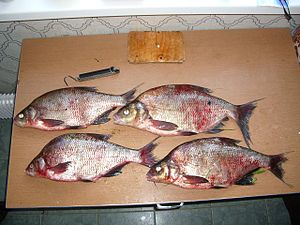
Chapter 11 assembled 20jy02
Fish is an excellent food for building and repairing muscle and other body-tissues. In addition, some fish, such as herrings, kippers, bloaters, mackerel, sardines, sprats, pilchards, eels, and salmon, are a good source of Vitamin D. These are generally known as the 'oily' fish because they contain fat. White fish, such as sole, plaice, cod, halibut, etc., do not contain fat and are not a good source of Vitamin D, though the livers of some are – for example, cod's liver.
Because Vitamin D is needed to build strong bones and teeth, children and expectant mothers are always advised to take cod-liver oil or one of the other fish-liver oils rich in this vitamin. Everybody needs some Vitamin D, and it is wise therefore to serve oily fish as often as possible.
The same fish are also a good source of Vitamin A, one of the vitamins which protect the body against ill- health. The most important nutrients in fish are not affected by preserving.
The ideal way to have fish is straight from the sea into the pan, but very few of us are able to do that. However, methods of keeping and transporting fish have improved a great deal in the last few years, and it is possible for those who live away from the coast to buy the excellent deep frozen fish.
The following are the characteristics of really fresh
110
fish, so bear them in mind when making your choice at the fishmonger's.
1. The gills should be bright and clear and difficult to open.
2. The fins should be tight and close.
3. The eyes should be full and bright, not sunken and dull.
4. The flesh should be firm, and no impression should be left when poked with the finger. Fillets and steaks should be firm, not flabby and watery.
5. There should be no unpleasant smell.
Fresh fish should be cooked the day it is bought, or, if in good condition, it may be kept in a refrigerator until the next day. In most refrigerators the best place is in the tray directly under the freezing unit. If placed elsewhere it must be put in a covered dish to prevent the fish smell from flavouring other foods. Smoked fish may be kept for 24 hours or 2 or 3 days in a refrigerator.
BREAM. Boiled, steamed, grilled, baked (stuffed or plain).

BRILL. Boiled, baked, grilled.
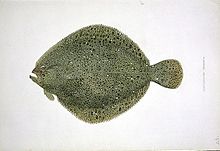
CARP. Boiled, stuffed, baked.
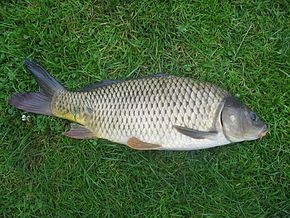
COD and COLEY. If fresh, any method. Also good for 'made-up' dishes. If salt, soak for 24-48 hours, then boil and use in 'made-up' dishes. If smoked, grill, boil, bake, or steam.
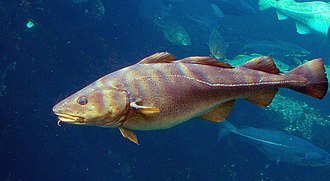
COCKLE5. Boiled, pickled.
.jpg)
CONGER EEL. If large, use for soup. If small, fry or stew like fresh-water eels.
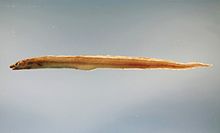
CRAB. Salads, sandwich fillings. Generally sold cooked.
DAB. Boiled, steamed, fried, baked.
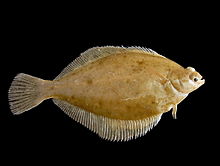
Eels. If fresh, boiled, fried, stewed, jellied, pies. If smoked, raw.
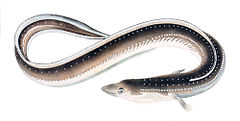
Pp112-3 ready to insert 22jy02
THE PENGUIN COOKERY BOOK
FINNAN HADDOCK. Grilled, boiled.
FLOUNDER. Fried, grilled.
.jpg)
GRAY MULLET. As Mackerel.
GURNET. Stuffed, baked, boiled (stuffed or plain), stewed.
HADDOCK. Boiled, stuffed, baked, stewed, fried.
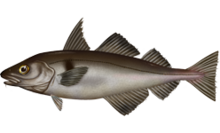
HAKE. As Haddock.

[g112]
|
|
|
HALIBUT. Boiled, baked, fried, grilled.
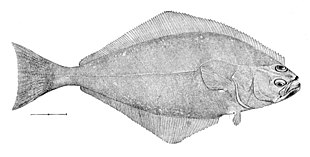
HERRING. Steamed, grilled, stuffed, baked, soused.

JOHN DORY. Boiled, steamed, baked.
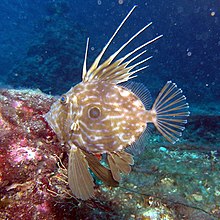
KIPPERS. Grilled.
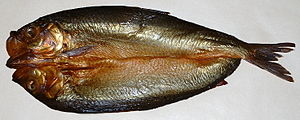
LING. As Cod.
LOBSTER. Generally sold cooked and used in salads, sauces, and sandwich fillings.
MACKEREL. Boiled, steamed, soused, stuffed, baked.
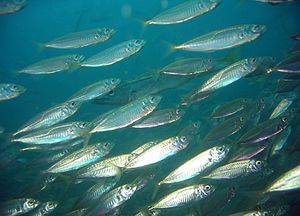
MUSSELS. Boiled, fried, soups, stews.
PERCH. Fried, boiled, stewed.
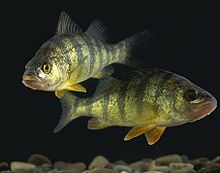
PILCHARDS. Fresh, as Herrings.
PLAICE. Fried, boiled, steamed, grilled, stuffed, baked.
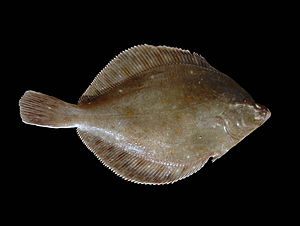
[g113] plaice, flounder, sole, mussels, mackerel, skate ray
|
|
|
114 THE PENGUIN COOKERY BOOK FISH
PIKE. As Carp.

PRAWNS. Generally sold cooked and used in salads and curry.
RED MULLET. Grilled or baked.
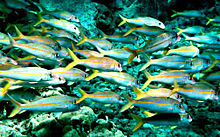
ROCK SALMON. As Cod.
SALMON. Boiled, steamed., grilled. If smoked, uncooked.

SCALLOPS. Fried, creamed.
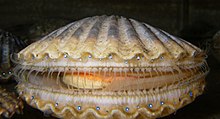
SKATE. Steamed, boiled.
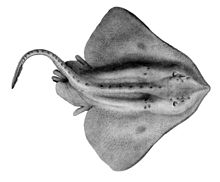
SMELTS. Fried, soused.

SOLE. As Plaice.
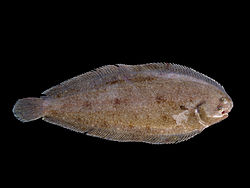
SPRATS. Grilled, fried, soused.

TROUT. Boiled, fried, grilled,, stuffed, baked, soused.

TURBOT. Boiled, steamed, fried, grilled.
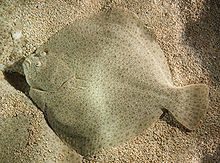
WHITEBAIT. Fried.
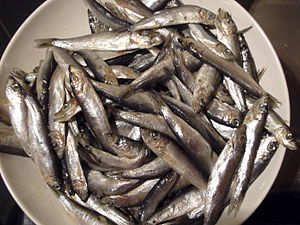
WHITING. Grilled, fried.
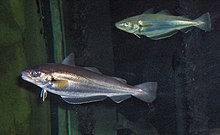
SCALING
Do this on a piece of paper, to catch the scales. Hold the fish by the tail and, with a knife in the other hand, scrape firmly from the tail towards the head. Wash to remove any loose scales. With certain fish, such as perch, the scales are very difficult to remove, and in this case the
fish should either be cooked with the scales on and skinned before serving, or plunged into boiling water for a minute or two, and then the scales removed.
CLEANING
ROUND FISH (e.g. cod, whiting, mackerel, etc.). With kitchen scissors or a sharp knife slit the belly from the head towards the vent, remove the entrails: keep the roe. The black skin lining the inside of some fish can be removed by rubbing with a little cooking-salt. Wash well and drain.
Small fish, such as herrings, may be cleaned without cutting the belly. Cut behind the back of the head, not
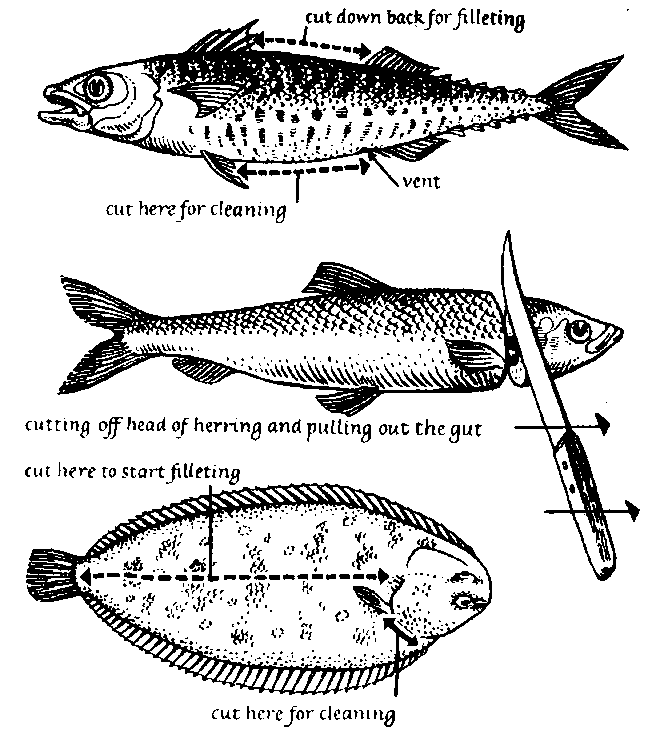
[g115]
quite through to the belly, and pull away from the fish, when the inside should come away with the head.
Red mullet and smelts are cleaned by pulling out the gills, when the inside should come with them.
FLAT FISH (e.g. soles, plaice, etc.). Cut away the gills and make a small opening just behind the head. Pull out the inside, and wash the fish well. Remove any dark skin as described above.
FILLETS. Place, skin side down, on a board. Hold the tail end in one hand, but first rub salt on the fingers to
THE PENGUIN CQOKERY BOOK
prevent them from slipping. Take a knife in the other hand and use it to scrape and roll the fillet from the skin.
ROUND FISH. Remove the fins and cut off a thin strip of skin down the back. Slit the skin along the belly from the vent to the tail. Cut the skin by the gills and pull off gradually, first one side and then the other.
FLAT Fish. Slit the skin across the tail end. Rub salt on the fingers to prevent them slipping and grasp the skin firmly. Pull quickly towards the head. Do the other side in the same way.
EELS. Hold the head in a cloth and cut through the skin round the neck. Turn back about an inch, and then pull the head with one hand and the skin with the other. It should pull off easily.
It is essential to have a sharp knife. Cut the fish down the backbone and slide the knife along close to the bones, cutting off the flesh. A flat fish will give four fillets, a round fish two. Use the bones and trimmings for Fish Stock, No. 33.
With a herring, after cutting down the backbone, open the fish with the finger and thumb and lift up the bone with the knife. If care is taken the small bones will come away with the backbone.
When carving or eating a whole cooked fish the same method of cutting down the backbone should be followed. The cooked flesh can then be easily removed from the bone.
Cooking time 7 minutes per lb. [450g] plus 7 minutes for thin fish; 10 minutes per lb. [450g] plus 10 minutes for thick fish. Fillets, steaks, small whole fish: 10-15 minutes.
FISH 117
Quantities: ½-¾ lb. [225-335g] per person.
1. For suitable fish see list, No. 226. Whole fish or cuts of large round fish are suitable, but thick steaks may also be boiled, although steaming, No. 237, is the more satisfactory way for these.
2. Use a pan just large enough to hold the fish and only enough water to cover. To each pint of water add ½ Tbs. vinegar, 1 tsp. salt, 2 peppercorns, 1 sprig parsley, ½ bay leaf, 1 small carrot and 1 small onion.
[g117]
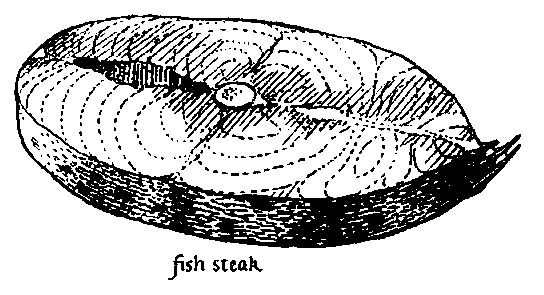
3. For small pieces of fish the water should be boiling, but whole fish should go into warm water, as the shrinkage caused by putting it into boiling water will cause the fish to lose its shape.
4. The water should not be allowed to boil after the fish has been added, for this needs to be 'poached' like an egg. You will find it easier to handle the fish if it is placed on a rack (sold for the purpose) or tied in a clean cloth.
5. To see if the fish is cooked test it at the thickest part with a fork, and if the flesh seems to come away easily from the bones it is done. Try not to overcook the fish, as this makes it dry and tasteless, and the flakes fall apart, spoiling the appearance. Lift but carefully and drain very thoroughly.
6. Serve with a sauce made with some of the fish
THE PENGUIN COOKERY BOOK
stock, e.g. Parsley Sauce, No. 89; Cheese Sauce, No. 75; Anchovy Sauce, No. 71; Chutney Sauce, No. 76; Egg Sauce, No. 78; Hollandaise Sauce, No. 81; Lobster or Shrimp Sauce, No. 83; Mussel Sauce, No. 85.
Plain boiled potatoes are generally considered the best, and any of the following vegetables are suitable: parsnips, green peas or beans, carrots, spinach, celery, tomatoes, green salad, beetroot, or cucumber salad. Left-over boiled fish may be used in Recipes Nos. 239-41 and 160.
Quantities: see No. 228.
1. Suitable for steaks, fillets, or small whole fish. This method is generally the one used for smoked fish.
2. Allow about ½ pt. [285ml] milk (1 c.) for 1 ½ lb. [1350g] fish. Add salt, and cook the fish very gently below boiling point until the flakes begin to show signs of separating.
3. Drain well, and use the milk to make a sauce to serve with the fish, as for Boiled Fish, No. 228. Use any of the vegetables given for Boiled Fish. Mustard sauce, No. 86, is good with smoked fish.
The head and shoulders make the best piece for boiling. Slices may be steamed. It keeps its shape better and is not so inclined to be watery if sprinkled with salt and left to stand for a couple of hours before cooking.
When eggs are plentiful, smoked haddock with poached eggs is popular. The eggs should be poached in the same milk in which the fish has been cooked. Serve on top of the fish, allowing them to break over it.
Cut four or five gashes about an inch deep on the sides of the fish and sprinkle well with salt. Leave for 2 hours, then boil according to No. 228. Serve with boiled parsnips sprinkled with chopped parsley and serve Egg Sauce, No. 78, separately.
Skin the eels and cook them as directed in No. 228. Serve with Parsley, No. 89, or Anchovy Sauce, No. 71.
Cook in milk or water according to No. 229. Keep hot, and use the milk to make Parsley Sauce, No. 89, or the water for Mustard Sauce, No. 86.
These must be very fresh. Boil according to No. 228, and serve with Fennel Sauce, No. 79.
This may be boiled in slices or in a whole piece. The latter is better for serving cold, as it keeps more moist. Serve with Cucumber Salad, No. 505, and boiled potatoes. The best sauces are Hollandaise, No. 81; Lobster or Shrimp Sauce, No. 83; Tartare Sauce, No. 115 or Brown Butter Sauce, No. 109.
Cold boiled salmon may be served with Mayonnaise,. No. 112, or Tartare Sauce, No. 115. For Salmon Salad see No. 514.
Skate needs to be very fresh, and the thick pieces are the best to buy. It should be boiled according to No. 228, and served with a Caper Sauce, No. 73, or Brown Butter Sauce, No. 109.
THE PENGUIN COOKERY BOOK
Quantities: see No. 228.
1. For suitable fish see list No. 226. Steaming is suitable for whole fish, cuts of fish, steaks, or fillets.
2. If no steamer is available, steaks or fillets may be cooked in a soup plate or deep dish over a pan of boiling water, using the lid of the pan to cover the fish.
3. Place the fish in the steamer or plate, sprinkle with salt, and cook until the flesh leaves the bones easily or until the flakes begin to separate.
Serve with a sauce and any of the vegetables given for Boiled Fish, No. 228. Any liquid with the fish should be added to the sauce.
Cook the herrings according to No. 237 and serve with Mustard Sauce, No. 86; or Caper Sauce, No. 73; or Fennel Sauce, No. 79.
Steamed herrings are also very good cold with salad.
Temperature 400 F. [204°C] Mark 6.
Quantities for 4 helpings:
4 lb. [1800g] hot mashed potato (3 c.)
6-8 Tbs. milk
Salt and pepper
1 lb. [450g] boiled, steamed, or canned fish, flaked (2 c.)
½ pt. [285ml] Cheese Sauce, No. 75, or Parsley Sauce, No. 89 (1 c.)
Margarine or dripping
Measures level. Mash the potato and milk until creamy, seasoning well. Line a pie-dish with a third of it. Mix the fish and sauce and season well. Pour into the dish and cover with the remaining potato. Dot the top with margarine or dripping and bake in a hot oven until brown on top and heated through.
FISH 121
Quantities for 4 helpings:
1 lb. [450g] boiled, steamed, or canned fish, flaked (2 c.)
¾ pt. [425ml] Parsley Sauce, No. 89 (1 ½ c.)
1 ½ lb. [1350g] freshly cooked mashed potatoes (3 c.)
4 oz. [110g] grated cheese (6 Tbs.)
3 Tbs. dried breadcrumbs
Margarine
Measures level. Mix the fish and sauce and make sure it is well seasoned. Make a border of the mashed potato on a fireproof dish; pour the fish mixture into the centre and sprinkle the cheese and crumbs over it. Dot with a little margarine and brown under a hot grill or in a hot oven.
Quantities for 4 helpings:
3 small onions
2 oz. [55g] butter (4 Tbs.)
1 Tbs. desiccated coconut
1 apple, finely chopped
Pinch of salt
½ Tbs. curry powder
1 Tbs. chutney
1 lb. [450g] cooked fish or shellfish
Juice of ½ lemon
Boiled rice
Measures level. Peel and slice the onions. Fry them brown in the butter. Add the coconut, apple, salt, curry powder, and chutney. Stir and heat until it is a deep brown. Add the fish and heat gently for a few minutes. Add lemon juice and serve with the boiled rice.
This is a very good method of using thick fillets of cod or other fish.
1.Cut the fish in 2-inch [50mm] pieces and put in a deep dish. Sprinkle well with salt and leave for half an hour or
THE PENGUIN COOKERY BOOK
longer. This draws out some of the moisture and makes the flesh firmer. Drain well.
2. Stewed fish is generally a very savoury dish, the foundation being some fried onions or leeks. Fry them brown in a little dripping, then add any other flavouring and a very little stock.
3. Add the fish and cook, below boiling, until the fish is tender. It may then be served with the cooking liquor, thickened if necessary.
Quantities for 4 helpings:
1 ½ lb. [1350g] fillets of fish
1 oz. [30g] dripping (2 Tbs.)
4 oz. [110g] onions sliced (1 c.)
2-3 Tbs. tomato puree or juice
½ tsp. paprika pepper
Measures level. Make according to No. 242, adding the tomato and paprika just before the fish. Shake the pan occasionally, and take care not to overcook, or the liquid will be watery. It should not need thickening. Serve with boiled potatoes and any green vegetable.
Cooking time 1½-2 hours.
Temperature 275 F. [135°C] Mark 2.
Quantities for 4 helpings:
8 herrings or similar amount of other fish
1 onion, sliced
6 cloves
1 tsp, peppercorns
1 tsp. salt
1 tsp. sugar
1 bay leaf
½ pt. [285ml} vinegar
Measures level.
1. Clean the fish, removing the heads and tails, but leaving the roes inside. Pack into a casserole.
FISH 123
2. Sprinkle with the seasonings and pour over the vinegar.
3. Cover and bake for at least 1 ½ hours in a slow oven. Longer cooking improves the flavour and makes the bones soft, so that they can be eaten.
4. Leave in the dish to become cold, and serve with some of the strained liquor as a sauce. Serve with boiled potatoes and lettuce salad.
Quantities: One steak or small fish per person.
1. If small whole fish are being cooked, cut two or three deep gashes on either side to allow the heat to reach the centre. For suitable fish, see No. 226.
2. The fish may be dipped in seasoned flour or left plain.
3. Heat the grill and grease the grid. Cutlets or white fish should be brushed with melted fat or basted with fat during cooking. Oily fish, such as herrings, mackerel, trout, and salmon, need no fat.
4. Grill gently until brown on one side, turn, and finish cooking. The fish is done when the flesh easily leaves the bones.
5. Serve at once with Tartare Sauce, No. 115, or Brown Butter, No. 109, or Parsley Butter, No. 122. Garnish with parsley or watercress and slices of lemon. Serve with fried or boiled potatoes; the best vegetables are parsnips, carrots, green peas or beans, grilled tomatoes, cucumber, beetroot, or green salad.
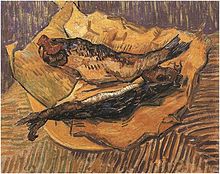
Slit down the backbone and grill for about 6 minutes; or remove the heads, slit down the backbone, open out,
124 THE PENGUIN COOKERY BOOK
and remove the roes and bone. Grill out flat until brown on both sides. Fry the roes golden in a little fat, and serve with the bloaters.
Serve hot with oatcakes and butter.
Steep in hot water for 1-2 minutes. Drain well. Place the fish on the grill, skin side down, put a little margarine on top, and cook for 5-8 minutes. Sprinkle with pepper and serve with lemon and brown bread-and-butter.
The steaks should be cut 1-1 ½ inches thick, and will need about 20-25 minutes to cook. Serve with Parsley Butter, No. 122, and Cucumber Salad, No. 505.
Quantities: 1 lb. for 3 people.
Thread on to skewers, run through the eyes, and grill quickly for 3-4 minutes. Serve very hot with lemon and brown bread-and-butter.
General directions for frying fish will be found in Chapter 8, Nos. 151-7. Sauces and accompaniments should be the same as for Grilled Fish, No. 245.
In addition to the ordinary methods, there are the two famous French methods of frying fillets and small fish called 'dore' and 'a Ia Meuniere'. In both these the fish is fried in butter, which naturally gives a delicious flavour. For 'dore' the fish is dipped in flour and then fried brown in a little butter. For 'a Ia Meuniere', after
125
frying in this way, the fish is sprinkled with lemon-juice,. salt and pepper, and chopped parsley. Then a little more butter is cooked until it goes brown, and quickly poured over the fish, which should be served at once. This is the best way of cooking trout and fillets of sole.
Skin the eel and cut it in 3-inch pieces. Egg and crumb and fry. Serve with Tartare Sauce, No. 115.
The herrings may be boned and opened out flat or fried whole. Sprinkle with salt and pepper and toss in coarse oatmeal until thoroughly coated. Fry in hot dripping until brown on both sides - about 10 minutes. Garnish with parsley and lemon. Serve with boiled potatoes.
To clean, pull out the gills; the insides should then come too. Coat with egg and crumbs and fry brown.
Toss the fish in a mixture of flour and fine breadcrumbs until the fish are well separated. Fry for 1 minute in deep fat. Serve with lemon and brown bread-and-butter.
Cut three gashes in each side of the fish. Dip in milk and then in flour to coat it evenly. Fry until golden brown in hot lard or oil. Sprinkle with salt and pepper and chopped parsley and serve lemon separately.
THE PENGUIN COOKERY BOOK
This method is most suitable for whole fish. Steaks or fillets may be stuffed and baked, but do not look as attractive as the whole fish. For names of suitable fish turn to No. 226.
Cooking time ¾-1 hour for large fish, 20-30 minutes for small fish.
Temperature 375 F. [191°C] Mark 5.
Quantities: ¾ lb. [335g] per person.
1. Clean the fish in the usual way, but leave the head on, merely removing the eyes.
2. Make a well-seasoned stuffing, such as No. 137 or 141. Fill the cleaned belly of the fish and sew up with a needle and coarse thread. Do not fill too full, as the stuffing swells during cooking, and may burst the fish. If you are stuffing a flat fish such as sole or plaice, cut the fish down the backbone as if you were going to fillet it, and push the stuffing in under the fillets. In this case the fish is not sewn up afterwards, and the stuffing is allowed to show through the centre.
3. The fish may either be brushed with melted fat or coated in egg and breadcrumbs; see No. 154.
4. Place in the baking-dish in a little hot fat, and cook in a moderate oven until tender. Before baking, the fish is sometimes skewered into the form of a letter 's', or
the tail is twisted round and fastened in the mouth.
5.Remove skewer and thread and garnish with parsley and lemon. Serve a fish sauce separately. Suitable ones are Nos. 72 or 92. Boiled or baked potatoes are best, and any of the following vegetables: parsnips, carrots, celery, spinach, tomatoes, green beans or peas, green salad, beetroot, or cucumber salad.
FISH
This method is most suited to fillets, steaks, and small whole fish. The dish does not necessarily contain cheese, as 'gratin' really means the crisp crust formed on top by the crumbs and fat.
Cooking time 20-30 minutes.
Temperature 375 F. [191°C] Mark 5.
Quantities: One steak or small fish per person.
1. Prepare the pieces of fish and place them in a fireproof dish. A shallow dish is best, as the fish will be served in it.
2. Cover with the sauce, which can be Cheese Sauce, No. 75, Tomato Sauce, No. 92; Parsley Sauce, No. 89; Anchovy Sauce, No. 71; Brown Sauce, No. 72; Egg Sauce, No. 78; Mustard Sauce, No. 86; or Sour-Sweet Onion Sauce, No. 90. With herrings and mackerel, Horse-radish Sauce, No. 82.
3. The sauce should be of coating consistency, and there should be just enough. to cover the fish. Sprinkle the top with browned breadcrumbs and dot with butter, margarine, or dripping.
4. Bake in a moderate oven until the fish is cooked. Test with a fork to see if the flakes separate easily.
5. Serve with fried or mashed potatoes and any of the vegetables given for No. 257.
Cooking time 20-30 minutes.
Temperature 375 F. [191°C] Mark 5.
Quantities: One small fillet or whole fish per person.
1.Prepare the fish and season it well. Whole fish may be stuffed as in No. 256. Fillets may be spread with a
128 THE PENGUIN COOKERY BOOK
thin layer of stuffing and then rolled up tightly. Fillets of sole and plaice are generally folded in two before baking.
2. Use a shallow baking-dish. Place the fish in a single layer. For extra flavour, it may be put on a bed of finely chopped or minced shallots and parsley, with some chopped mushrooms, if available.
3. Pour over very little liquid - only just enough to moisten, as it should be nearly all evaporated by the time cooking is finished. Suitable liquids are: Fish Stock, No. 33, red or white wine, cider, Mushroom Stock, No. 34, or lemon-juice and melted butter.
4. Bake in a moderate oven until the flesh is tender and the flakes part when tested. Baste once or twice during cooking.
5. Drain the fish and add any liquid to the sauce. This fish is always served with a sauce poured over it, and may be decorated with a border of Duchess Potatoes, No. 464, or small Stuffed Tomatoes, No. 485, or other vegetables. Suitable sauces are the same as for No. 258 or use Oyster or Mussel Sauce, No. 85, or Shrimp or Lobster Sauce, No. 83.
Temperature 375 F. [191°C] Mark 5.
Quantities for 2 helpings:
6 oz. [170g] smoked fish fillets
¼ tsp. pepper
1 Tbs. water
1 oz. [30g] butter or margarine (2 Tbs.)
2-4 thin rashers bacon
6 oz. [170g] tomatoes, skinned
Measures level. Put the fish in a greased pie-dish and cover with the tomatoes, sliced. Sprinkle with pepper and dot with the butter. Add the water and cover with the rashers of bacon. Bake until the fish is tender. Serve with mashed potatoes.
129 FISH
Canned fish should keep for several years in a cool, dry. place, but the tins must not be allowed to become damp or rust will eat through and make them leak. Turn the cans over occasionally to keep the contents well mixed with the liquid. Discard any tins which are 'blown' - that is, bulge at the ends instead of being flat.
After opening, canned fish will not keep any longer than cooked fresh fish.
The bones of canned fish are soft, and can be eaten. They contain calcium, which the body needs for strong bones and teeth.
Salad, No. 275
Patties, No. 276
Sandwich Filling, No. 788
Curry (heat fish in Sauce, No. 77)
Fish Cakes, No. 160
Salad, No. 506
Open Sandwich, No. 790
Methods. Place the fish on slices of toast and heat under the grill.
Method 2. Heat the fish in a frying-pan and serve on slices of fried bread.
Sauce for fish, No. 85
Soup, No. 54
Patties as in #276
Hors-d'oeuvre, No. 851
Fried in batter
Hors-d’oeuvre, #292
Salad, #291
Heat in Curry Sauce, see #77
Fish Cakes, #760
Fritters, #762
Fish Pie, #239
Sandwich, #788 and 789
Au Gratin, #240
Salad, #514
Temperature 375 F. [191°C] Mark 5.
Quantities for 4 helpings:
1 tsp. salt
1 tsp. lemon-juice
¼ tsp. pepper
Pinch of mace
1 c. mashed salmon
½ c. milk
1 c. stale breadcrumbs
2 eggs
Measures level. Mash the fish, including the bone, which is quite soft. Heat the milk and pour on to the breadcrumbs. Soak for a minute or two. Add the egg yolks, fish, and the seasonings. Add the beaten egg whites. Pour into a well-greased 1-lb-loaf tin and bake in a moderate oven until set. Turn out.
Serve with boiled or mashed potatoes and green peas or baked tomatoes. Mask with Parsley Sauce, #89, or Tomato Sauce, #92.
Fish Cakes, #160
Hors-d’oeuvre, #855
Sandwich, #788 and 790
Quantities for 4 helpings:
6-8 sardines
4 slices toast
½ Pt. [285ml] Cheese Sauce, #75 (1 c.)
Chopped parsley
Arrange the sardines on the toast and warm under the grill. Pour the hot sauce over and decorate with chopped parsley.
Fish Stuffing, #137 (use 1 or 2 anchovies in place of the essence)
Hors-d'oeuvre, #839
Salad, #504
With the exception of oysters and mussels, shell-fish are usually sold cooked. The live fish is thrown into boiling water, the boiling time varying with the size: 5 minutes for shrimps, 7-8 minutes for prawns, 15-20 minutes for lobsters or crabs.
Crabs, lobsters, prawns, and shrimps are all regarded as rather indigestible. Vinegar, or a sauce containing vinegar, or lemon-juice, is generally served with them, as the acid present in these helps to soften the fish fibres and to stimulate the flow of digestive juices, making for better digestion.
Medium-sized crabs (6-10 inches across in the widest part) are generally regarded as the best buy. They should have large claws, and all the claws should be on,
132 THE PENGUIN COOKERY BOOK
because if a claw comes off during cooking, water seeps in and makes the inside damp. Another indication of good quality is for the crab to be heavy in proportion to its size and for the shell to be rough and bright in colour. The claws should be stiff.
To prepare crabs pull off the claws, crack them, using a hammer or nut-crackers, and pick out the flesh. Turn the crab on its back, and, with a sharp-pointed knife, remove the ‘apron’, the small pointed piece at the lower part of the shell. Separate the upper and lower shells.
Pick out the flesh from the shell, taking out any hard pieces of tendon. The yellow liver is used as well as the white flesh, but the gills, stomach, and green intestine should be discarded.
Quantities for 3 helpings:
1 medium-sized crab
Salt, mustard, and cayenne pepper
2 Tbs. vinegar
2 Tbs. oil
Lemon and parsley
Mix the flesh with the oil and vinegar and season well. Wash the shell, dry it thoroughly, and put the flesh back inside. Decorate with slices of lemon and the parsley. If preferred, the crab may be prepared in individual portions and served in small scallop shells, or in a nest of lettuce leaves.
Use the same mixture as #274 and serve it on a bed of lettuce and decorate with cress and tomatoes.
Mix 1 c. crab meat with 1 c. Parsley Sauce, #89. Season well, and add a little lemon-juice or vinegar to taste. Serve in Patty-cases, #719.
Quantities for 3 helpings:
1 medium-sized crab
2 tsp. lemon-juice
1 Tbs. cream or top milk
2 tsp. vinegar
2 tsp. chopped parsley
Pinch of cayenne pepper
3 Tbs. breadcrumbs
½ tsp. anchovy essence
½ oz. [15g] butter or margarine (1 Tbs.)
Paprika pepper
Toast
Measures level. Mix the crab meat with the other ingredients and heat in a pan. Serve in hot scallop-dishes and decorate the top with paprika pepper. Serve hot toast separately.
A good lobster should be heavy in proportion to its size, and the tail should feel springy if pulled back a little.
To prepare a lobster for serving break off the claws. If there is any spawn ‘coral’ under the tail, keep it for decorating the dish. Crack the claws with a hammer. Remove the small intestinal vein which runs down the centre of the tail. Cut the body and tail lengthwise
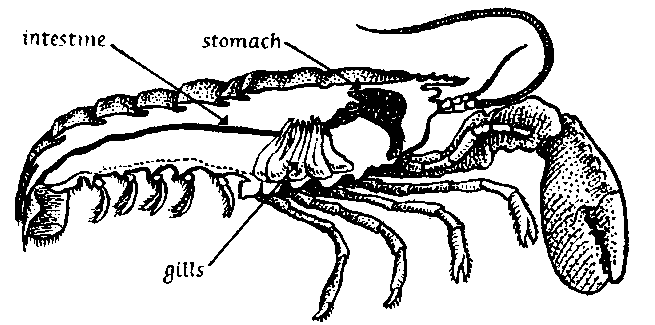
[g
133]
through the middle and remove the flesh, discarding the stomach and the green liver, also the gills at the sides of the body. The shell of the body and tail may be washed and dried and used to hold the meat for serving.
THE PENGUIN COOKERY BOOK
This is usually served split in half and decorated with the claws arranged neatly round and with parsley or lettuce heart. A French Dressing, #116, or Mayonnaise, #112, is served with it.
Arrange pieces of lobster on a nest of fresh, crisp lettuce and cover the lobster with Mayonnaise, #112. Decorate with the coral.
Quantities for 4 helpings:
1 medium lobster (about 2 lb.[900g])
1 ½ oz. [40g] butter or margarine (3 Tbs.)
2 tsp. chopped onion
2 Tbs. flour
½ pt. [285ml] milk (1 c.)
Cayenne pepper
Salt to taste
2 Tbs. chopped parsley
2 tsp. lemon-juice
½ tsp, anchovy essence
1 egg-yolk
3-4 Tbs. Fresh breadcrumbs
Measures level. Save the four pieces of lobster shell and clean them for serving. Cut the meat in slices. Melt the butter or margarine and cook the onion for a minute or two without browning. Add the flour, mix well, and then add the milk. Stir until it boils. Boil for 5 minutes. Then add the seasonings and the egg and cook for another minute or two. Mix in the lobster. Fill the lobster-shells and cover the top with breadcrumbs. Dot with a little butter or margarine and bake in a moderate oven for 20 minutes or brown under the grill.
Mix 1 c. lobster meat with 1 c. thick Tomato Sauce, #92. Use to fill Patty-cases, #719.
FISH 135
The shells should be closed tightly. Discard any which are even slightly open, as this indicates staleness. Wash the mussels in several waters, brushing off as much of the sand as possible. To make the shells open, put the mussels in a pan with a very little water and put the lid on. Cook gently until the shells open. Then strain the liquor and keep it for the sauce. Remove any weed there may be under the black tongue.
Cook as described in #283. Leave in one half of the shell. Serve vinegar and brown bread-and-butter with them.
Quantities for 2 helpings:
1 qt. [1140ml] of mussels
1 oz. [30g] butter or margarine (2 Tbs.)
Salt and pepper
1 Tbs. lemon-juice
1 tsp. Worcester Sauce
Measures level. Prepare the mussels as described for No. 283. Mix the liquor with the other ingredients and pour over the mussels. Serve hot with brown bread-and-butter.
Quantities for 3 helpings:
3 pt. [1710ml] mussels
2 oz. [55g] butter or margarine (4 Tbs.)
1 tsp. chopped chives
1 tsp. chopped parsley
2 Tbs. fine breadcrumbs
1 c. water and liquid from fish
Juice of ½ lemon
Measures level. Cook the mussels as described in #283, saving the liquor. Remove half the shells, leaving the mussels attached to the other halves. Make the liquor up to 1 cup with water and mix in a pan with the butter, chives, parsley, and breadcrumbs. Boil for 2 minutes with the mussels. Squeeze over the lemon-juice and serve hot, with bread-and-butter.
If oysters are fresh they should be difficult to open and should close hard on the knife when inserted for opening.
To open, hold the oyster in a cloth with the deep shell at the bottom to catch the juice. Slide the knife in with a see-saw movement.
Prepare as described in #287, and leave the oysters in the deep shell with their juice. Stand on crushed ice for an hour before serving. Serve with vinegar or lemon, pepper, and brown bread-and-butter.
If fresh they have a sweet smell.
When cooked prawns are stale, the tails are limp and the fish pale and clammy with a pungent smell.
Shelling is very difficult if the prawns are at all stale. Hold the head and part of the body in the thumb and forefinger of the right hand. Hold three joints of the tail with the left hand and bend back a little. Then pull the end of the tail, and the tail-shell should come off. Hold the body and gently pull out of the head and body-shell.
Quantities for 4 helpings:
1 pt. [570ml] prawns (2 c.)
½pt. [285ml] Curry Sauce, #77 (1 c.)
4 oz. [110g] Rice (½c.), boiled
136 THE PENGUIN COOKERY BOOK
FISH 137
Make the curry sauce and heat the prawns in it. Let them stand for 5 or 10 minutes to absorb the flavour of the curry. Serve with the boiled rice.
Arrange prawns on a bed of crisp lettuce. Squeeze lemon- or lime-juice over them and cover with Mayonnaise, #112.
Sprinkle with lemon-juice or lime-juice, and serve very cold with brown bread-and-butter.
These are generally sold already opened, but must be very fresh. Cut off the beards, but leave the black, white, and orange parts. The deep shells are useful for serving various savoury dishes.
Allow two scallops per person. Dry them well, dip in seasoned flour, and then in Fritter Batter, #760. Fry in deep fat until brown: see #157. Serve with lemon or with Tomato Sauce, #92.
Temperature 375 F. [191°C] Mark 5.
Quantities for 4 helpings:
8 scallops
½ c. Medium Sauce, White, #69
Cayenne pepper and salt
Chopped parsley
Lemon-juice
Breadcrumbs
Grease four deep scallop shells and strew on a few breadcrumbs. Put two scallops in each, and sprinkle on a few grains of cayenne pepper, a little lemon-juice, and
138 THE PENGUIN COOKERY BOOK
chopped parsley. Cover the scallops with the well-seasoned sauce and sprinkle with breadcrumbs. Put a small knob of butter or margarine on top of each. Bake for about 20 minutes in a moderate oven. Serve hot.
Prepare and use in the same way as Prawns, Nos. 289-91
Shell the shrimps and mash them with just enough butter to bind them well, or, an alternative method, put the shrimps in small jars and pour over melted butter to cover. Serve with toast or brown bread-and-butter.
Hard or soft roes may be used. Dip in flour or in egg and breadcrumbs and fry in shallow fat until light brown. Serve on toast with lemon.
Quantities for 4 helpings:
8 soft roes
1 pt. [570ml] milk (~ c.)
4 slices toast
1 ½ Tbs. flour
Salt and pepper, lemon juice
Chopped parsley
Measures level. Stew the roes in the milk until they are opaque and firm. This takes about 10-15 minutes. Place two roes on each piece of toast and keep hot. Mix the flour to a paste with a little cold water. Add the hot milk. Return to the pan and stir until it boils. Cook for 5 minutes. Season well, add lemon-juice, and pour over the roes. Garnish with chopped parsley.
139 FISH
Tie the roe in a thin cloth to keep it in shape. Put into boiling salted water and cook very gently for about half an hour. Lift out of the pan, but leave in the cloth until quite cold. Cut in 1-inch slices and dust with flour. Fry in hot fat until well browned and crisp. Serve with slices of lemon.